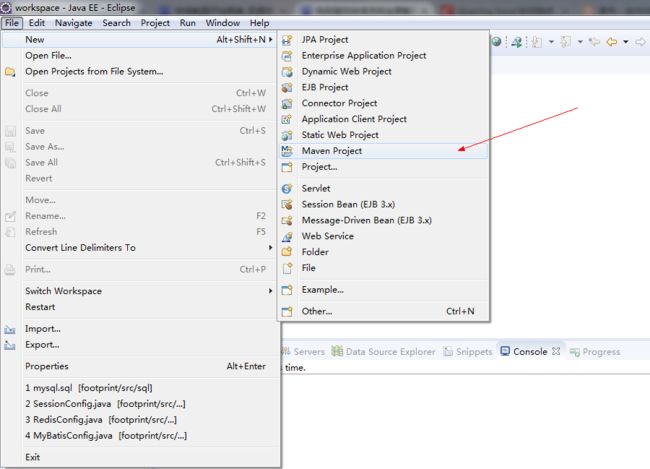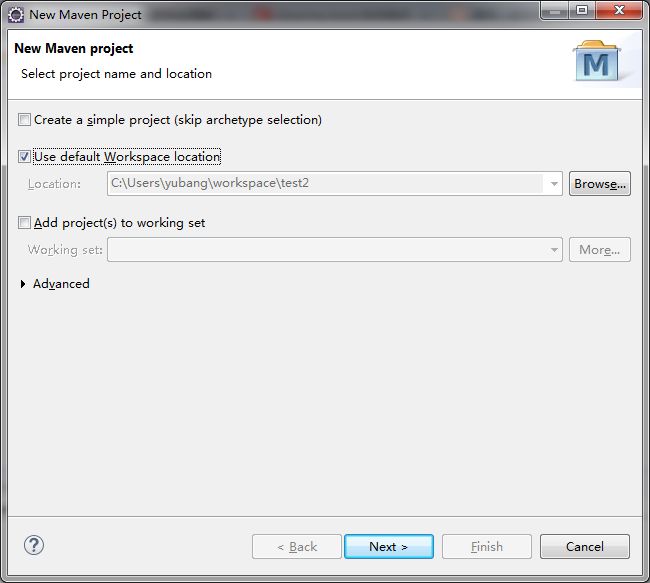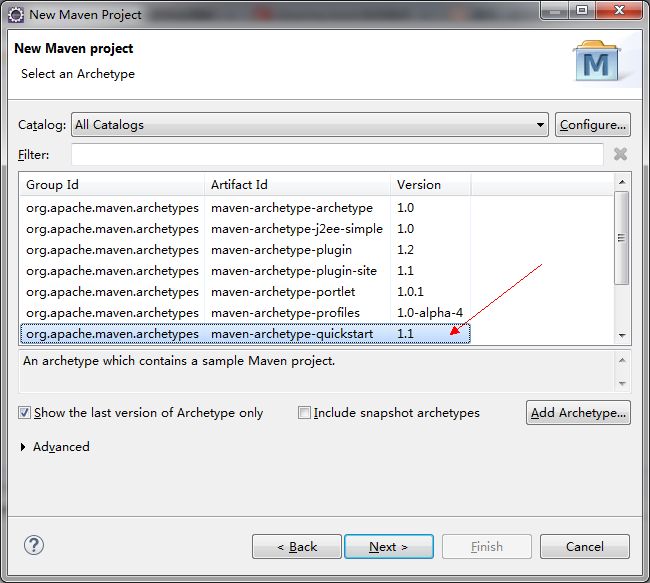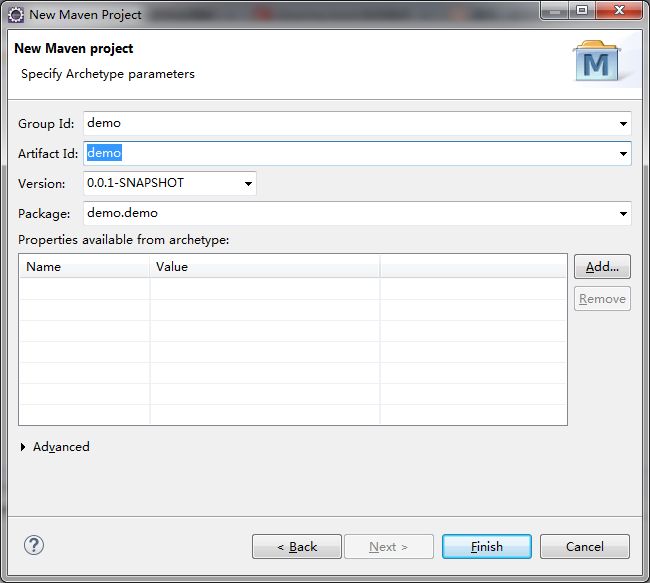为什么要使用spring boot?
- 入门简单,无需编写大量的xml文件来配置应用
- 内置tomcat,可以生成直接运行的独立jar文件
- 简化了spring框架一些繁琐的开发方式,提供很多与第三方库的结合
使用eclipse新建一个spring boot工程
1.先在eclipse官网下载一个eclipse EE
2.new -> Maven Project
3.填写项目信息
** 安装spring boot依赖 **
在pom.xml文件添加一点点东西(保存的时候eclipse会自动下载依赖),整个文件如下:
4.0.0
demo
demo
0.0.1-SNAPSHOT
jar
demo
http://maven.apache.org
UTF-8
org.springframework.boot
spring-boot-starter-parent
1.5.4.RELEASE
org.springframework.boot
spring-boot-starter-web
路由配置(输出hello world)
在默认生成的App.java文件修改成下面的代码:
package demo.demo;
import org.springframework.boot.SpringApplication;
import org.springframework.boot.autoconfigure.EnableAutoConfiguration;
import org.springframework.boot.context.embedded.ConfigurableEmbeddedServletContainer;
import org.springframework.boot.context.embedded.EmbeddedServletContainerCustomizer;
import org.springframework.boot.web.support.SpringBootServletInitializer;
import org.springframework.stereotype.Controller;
import org.springframework.web.bind.annotation.RequestMapping;
import org.springframework.web.bind.annotation.ResponseBody;
@Controller
@EnableAutoConfiguration
public class App extends SpringBootServletInitializer implements EmbeddedServletContainerCustomizer {
@RequestMapping("/")
@ResponseBody
String home() {
return "Hello World!";
}
public void customize(ConfigurableEmbeddedServletContainer container) {
container.setPort(8000);
}
public static void main( String[] args ){
SpringApplication.run(App.class, args);
}
}
然后我们运行这个文件,在浏览器访问 http://127.0.0.1:8000/ 即可看到效果。
我们来分析这个文件做了什么:
其中main方法的代码就是启动spring boot应用
继承SpringBootServletInitializer 类实现EmbeddedServletContainerCustomizer 接口编写customize方法其实是为了修改spring boot应用监听的端口
类的两个修饰器,@Controller是声明是一个控制器类,@EnableAutoConfiguration大概是自动加载一些bean
我们输出Hello World!的方法也有两个修饰器,@RequestMapping("/")是绑定路由,就是浏览器域名端口后面的一段字符串(不包括get参数),@ResponseBody表示输出字符串到浏览器
也许你会问,我如何限制get或者post方法请求该方法?
@RequestMapping(value="/", method=RequestMethod.POST)
@ResponseBody
String home() {
return "Hello World!";
}
get请求: RequestMethod.GET
post请求:RequestMethod.POST
put请求: RequestMethod.PUT
delete请求: RequestMethod.DELETE
现在可以限制请求方式了,但是我想正则匹配路由又该如何处理呢?
@RequestMapping("/test/{a}/*/{b:\\d+}")
@ResponseBody
public String index(@PathVariable int b, @PathVariable String a){
System.out.println(a);
System.out.println(b);
return "test!";
}
请求 http://127.0.0.1:8000/test/cbd/qwe/123 就可以看到效果!
- {XXX}来匹配一个任意字符串
- {xxx:正则表达式}来匹配符合规则的字符串
- *匹配任意字符串
- @PathVariable 修饰器把{X}的内容注入方法的参数里面
GET,POST参数获取
@RequestMapping("/test")
@ResponseBody
public String test(HttpServletRequest request){
return request.getParameter("a");
}
使用HttpServletRequest 对象的getParameter方法即可获取get或者post参数,如果参数不存在则返回null
输出结果设置headers
@RequestMapping(value="/test2", produces="text/plain")
@ResponseBody
public String test2(HttpServletResponse response){
response.setHeader("own", "m");
return "ok";
}
修改content-type需要在修饰器的produces参数指定
自定义header调用setHeader方法即可
** 上传和下载文件 **
先看demo代码:
@Bean
public MultipartConfigElement multipartConfigElement() {
MultipartConfigFactory factory = new MultipartConfigFactory();
factory.setMaxFileSize("128KB");
factory.setMaxRequestSize("128KB");
return factory.createMultipartConfig();
}
@RequestMapping(value = "/upload", method = RequestMethod.POST)
@ResponseBody
public String upload(@RequestParam("file") MultipartFile file, HttpServletResponse response) throws IOException {
response.setContentType("application/octet-stream");
OutputStream os = response.getOutputStream();
os.write(file.getBytes());
return "upload!";
}
其实很简单,接收文件只要在参数加上@RequestParam("file") MultipartFile file。"file"是post文件的变量名字
下载文件,先拿输出response.getOutputStream();。当然记得要设置content-type
模板渲染
这里使用了Thymeleaf模板引擎,其他模板引擎实在搜不出可运行方案。
第一步添加依赖:
org.springframework.boot
spring-boot-starter-thymeleaf
第二步,在src/main/resources/templates文件夹编写模板文件,以.html结尾
第三步,编写代码返回模板
package demo.controller;
import org.springframework.stereotype.Controller;
import org.springframework.web.bind.annotation.RequestMapping;
@Controller
public class Debug {
@RequestMapping("/index")
public String index2(){
return "web";
}
}
注意返回的字符串不需要加上.html。
静态文件处理
新建一个类(这里是StaticConfig),继承WebMvcConfigurerAdapter类,重写addResourceHandlers方法,代码如下:
package demo.config;
import org.springframework.context.annotation.Configuration;
import org.springframework.web.servlet.config.annotation.ResourceHandlerRegistry;
import org.springframework.web.servlet.config.annotation.WebMvcConfigurerAdapter;
@Configuration
public class StaticConfig extends WebMvcConfigurerAdapter {
@Override
public void addResourceHandlers(ResourceHandlerRegistry resourceHandlerRegistry) {
resourceHandlerRegistry.addResourceHandler("/static/**").addResourceLocations("classpath:/static/");
super.addResourceHandlers(resourceHandlerRegistry);
}
}
静态文件放在src/main/resources/static文件夹即可
当然为了让配置生效,我们需要在主类增加注解@ComponentScan("demo.config"),demo.config换成你新建类的包名
允许跨域请求
只需要往入口类添加下面代码:
// 允许跨域请求
@Bean
public WebMvcConfigurer corsConfigurer() {
return new WebMvcConfigurerAdapter() {
@Override
public void addCorsMappings(CorsRegistry registry) {
registry.addMapping("/**").allowedOrigins("*");
}
};
}
数据库操作
1.第一步当然是引入依赖咯,往pom.xml里面添加下面代码:
org.springframework.boot
spring-boot-starter-jdbc
com.alibaba
druid
1.0.14
mysql
mysql-connector-java
runtime
org.mybatis
mybatis
3.2.8
org.mybatis
mybatis-spring
1.2.2
2.新建一个类用于配置数据库信息
package demo.config;
import java.util.Properties;
import javax.sql.DataSource;
import org.apache.ibatis.session.SqlSessionFactory;
import org.mybatis.spring.SqlSessionFactoryBean;
import org.springframework.beans.factory.annotation.Value;
import org.springframework.context.annotation.Bean;
import org.springframework.context.annotation.Configuration;
import org.springframework.context.annotation.PropertySource;
import com.alibaba.druid.pool.DruidDataSourceFactory;
@Configuration
@PropertySource(value="classpath:/demo/config/db_local.properties", ignoreResourceNotFound=true)
public class MyBatisConfig {
@Value("${driverClassName}")
private String driverClassName;
@Value("${url}")
private String url;
@Value("${db_username}")
private String username;
@Value("${password}")
private String password;
/**
* 创建数据源
* @Primary 该注解表示在同一个接口有多个实现类可以注入的时候,默认选择哪一个,而不是让@autowire注解报错
*/
@Bean
//@Primary
public DataSource getDataSource() throws Exception{
Properties props = new Properties();
props.put("driverClassName", this.driverClassName);
props.put("url", this.url);
props.put("username", this.username);
props.put("password", this.password);
return DruidDataSourceFactory.createDataSource(props);
}
/**
* 根据数据源创建SqlSessionFactory
*/
@Bean
public SqlSessionFactory sqlSessionFactory(DataSource ds) throws Exception{
SqlSessionFactoryBean fb = new SqlSessionFactoryBean();
fb.setDataSource(ds);//指定数据源(这个必须有,否则报错)
//下边两句仅仅用于*.xml文件,如果整个持久层操作不需要使用到xml文件的话(只用注解就可以搞定),则不加
//fb.setTypeAliasesPackage("com.xxx.firstboot.domain");//指定基包
//fb.setMapperLocations(new PathMatchingResourcePatternResolver().getResources("classpath:mapper/*.xml"));//指定xml文件位置
return fb.getObject();
}
}
当然入口类记得加上扫描(@ComponentScan("demo.config"))
上面数据库密码那些是读取了配置文件所以新建一个配置文件(配置文件读取参考下文说明)
driverClassName=com.mysql.jdbc.Driver
url=jdbc:mysql://127.0.0.1:3306/map?zeroDateTimeBehavior=convertToNull&useUnicode=true&characterEncoding=utf-8
db_username=root
password=root
3.定义操作数据表的接口
import java.util.List;
import org.apache.ibatis.annotations.Select;
public interface SpecialtyMapper {
@Select("select * from specialty where province = #{province};")
List getSpecialtyList(String province);
}
当然,我们要在入口类用修饰器扫描这些模型类,@MapperScan("demo.mapper")
trip.footprint.dao.SpecialtyDao只是一个普通的java类,用于存储查询到的数据
package demo.dao;
import java.sql.Timestamp;
public class SpecialtyDao {
private int id;
private String province;
private String title;
private String img;
private Timestamp create_time;
private Timestamp update_time;
public int getId() {
return id;
}
public void setId(int id) {
this.id = id;
}
public String getProvince() {
return province;
}
public void setProvince(String province) {
this.province = province;
}
public String getTitle() {
return title;
}
public void setTitle(String title) {
this.title = title;
}
public String getImg() {
return img;
}
public void setImg(String img) {
this.img = img;
}
public Timestamp getCreate_time() {
return create_time;
}
public void setCreate_time(Timestamp create_time) {
this.create_time = create_time;
}
public Timestamp getUpdate_time() {
return update_time;
}
public void setUpdate_time(Timestamp update_time) {
this.update_time = update_time;
}
}
4.在controller中使用
package demo.controller;
import org.springframework.beans.factory.annotation.Autowired;
import org.springframework.web.bind.annotation.RequestMapping;
import org.springframework.web.bind.annotation.ResponseBody;
import org.springframework.web.bind.annotation.RestController;
@RestController
public class Debug {
@Autowired
private demo.mapper.SpecialtyMapper specialtyMapper;
@RequestMapping("/abc")
@ResponseBody
public String index(){
specialtyMapper.getSpecialtyList("广东省");
return "ok";
}
}
session放于redis
新建一个java类
package trip.footprint.config;
import org.springframework.beans.factory.annotation.Value;
import org.springframework.context.annotation.Bean;
import org.springframework.context.annotation.Configuration;
import org.springframework.context.annotation.PropertySource;
import org.springframework.data.redis.connection.jedis.JedisConnectionFactory;
import org.springframework.session.data.redis.config.ConfigureRedisAction;
import org.springframework.session.data.redis.config.annotation.web.http.EnableRedisHttpSession;
@Configuration
@EnableRedisHttpSession
@PropertySource(value = "classpath:/trip/footprint/config/redis_bae.properties")
public class SessionConfig {
@Value("${redisHost}")
private String redisHost;
@Value("${redisPort}")
private int redisPort;
@Value("${redisPassword}")
private String redisPassword;
@Value("${redisDb}")
private int redisDb;
@Bean
public static ConfigureRedisAction configureRedisAction() {
return ConfigureRedisAction.NO_OP;
}
@Bean
public JedisConnectionFactory connectionFactory() {
JedisConnectionFactory factory = new JedisConnectionFactory();
factory.setHostName(redisHost);
factory.setPort(redisPort);
if(redisDb!=-1){
factory.setDatabase(redisDb);
}
if (!redisPassword.equals("")) {
factory.setPassword(redisPassword);
}
return factory;
}
}
然后记得用@ComponentScan("demo.config")来扫描加载
由于代码读取配置文件,所以新建一个配置文件
redisHost=127.0.0.1
redisPort=6379
redisPassword=
redisDb=0
controller分离成多个文件
其实每一个controller都是一个java类,只是类上面有一个修饰器@Controller或者@RestController。当然记得用@ComponentScan("xxx.xxx")来扫描加载
依赖注入
首先想把类A作为一个变量注入类B,就需要用修饰器@ComponentScan扫描类A和类B的包,同时类A要在类上面加入修饰器@Component,类B变量上面添加修饰器 @Autowired。
类A代码:
package demo.data;
import org.springframework.stereotype.Component;
@Component
public class A {
public String data = "good!";
}
类B代码:
package demo.controller;
import org.springframework.beans.factory.annotation.Autowired;
import org.springframework.web.bind.annotation.RequestMapping;
import org.springframework.web.bind.annotation.ResponseBody;
import org.springframework.web.bind.annotation.RestController;
@RestController
public class Debug {
@Autowired
private demo.mapper.SpecialtyMapper specialtyMapper;
@Autowired
private demo.data.A a;
@RequestMapping("/abc")
@ResponseBody
public String index(){
specialtyMapper.getSpecialtyList("广东省");
return a.data;
}
}
读取配置文件
读取配置文件需要使用修饰器,@PropertySource(value = "classpath:/trip/footprint/config/redis_bae.properties")。classpath后面跟着的是配置文件路径。当然入口类记得用@ComponentScan("demo.config")扫描包。加载配置文件,当然要注入变量,用修饰器@Value("${变量名}")即可注入。代码如下:
package demo.config;
import java.util.Properties;
import javax.sql.DataSource;
import org.apache.ibatis.session.SqlSessionFactory;
import org.mybatis.spring.SqlSessionFactoryBean;
import org.springframework.beans.factory.annotation.Value;
import org.springframework.context.annotation.Bean;
import org.springframework.context.annotation.Configuration;
import org.springframework.context.annotation.PropertySource;
import com.alibaba.druid.pool.DruidDataSourceFactory;
@Configuration
@PropertySource(value="classpath:/demo/config/db_local.properties", ignoreResourceNotFound=true)
public class MyBatisConfig {
@Value("${driverClassName}")
private String driverClassName;
@Value("${url}")
private String url;
@Value("${db_username}")
private String username;
@Value("${password}")
private String password;
/**
* 创建数据源
* @Primary 该注解表示在同一个接口有多个实现类可以注入的时候,默认选择哪一个,而不是让@autowire注解报错
*/
@Bean
//@Primary
public DataSource getDataSource() throws Exception{
Properties props = new Properties();
props.put("driverClassName", this.driverClassName);
props.put("url", this.url);
props.put("username", this.username);
props.put("password", this.password);
return DruidDataSourceFactory.createDataSource(props);
}
/**
* 根据数据源创建SqlSessionFactory
*/
@Bean
public SqlSessionFactory sqlSessionFactory(DataSource ds) throws Exception{
SqlSessionFactoryBean fb = new SqlSessionFactoryBean();
fb.setDataSource(ds);//指定数据源(这个必须有,否则报错)
//下边两句仅仅用于*.xml文件,如果整个持久层操作不需要使用到xml文件的话(只用注解就可以搞定),则不加
//fb.setTypeAliasesPackage("com.xxx.firstboot.domain");//指定基包
//fb.setMapperLocations(new PathMatchingResourcePatternResolver().getResources("classpath:mapper/*.xml"));//指定xml文件位置
return fb.getObject();
}
}
配置文件如下:
driverClassName=com.mysql.jdbc.Driver
url=jdbc:mysql://127.0.0.1:3306/map?zeroDateTimeBehavior=convertToNull&useUnicode=true&characterEncoding=utf-8
db_username=root
password=root
日志输出
在src/main/resources新建一个文件,写入下面内容:
logging.file=log/myapp.log
logging.level.org.springframework.web=DEBUG
logging.level.root=DEBUG
代码输出日志,代码如下:
package demo.controller;
import org.slf4j.Logger;
import org.slf4j.LoggerFactory;
import org.springframework.beans.factory.annotation.Autowired;
import org.springframework.web.bind.annotation.RequestMapping;
import org.springframework.web.bind.annotation.ResponseBody;
import org.springframework.web.bind.annotation.RestController;
@RestController
public class Debug {
@Autowired
private demo.mapper.SpecialtyMapper specialtyMapper;
@Autowired
private demo.data.A a;
private final Logger logger = LoggerFactory.getLogger(this.getClass());
@RequestMapping("/abc")
@ResponseBody
public String index(){
logger.debug("ceshi");
logger.info("对的");
specialtyMapper.getSpecialtyList("广东省");
return a.data;
}
}
导出成war
其实主要是修改pom.xml,添加下面代码:
org.springframework.boot
spring-boot-starter-tomcat
provided
org.springframework.boot
spring-boot-maven-plugin
maven-war-plugin
3.0.0
false
修改pom.xml文件的packaging标签变成
然后再用maven build一下:




